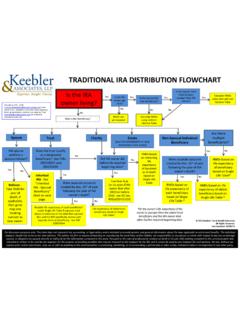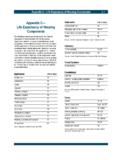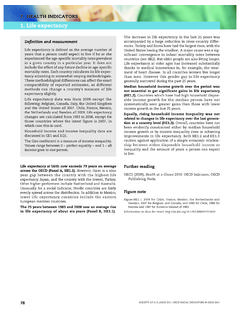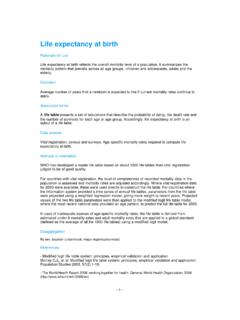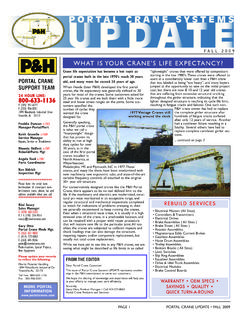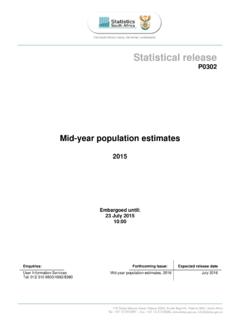Transcription of Whose Life Expectancy Is It, Anyway? Determining …
1 JOURNAL OF RETIREMENT PLANNING29 July August 2008 2008 L. Ward is a manager in the Financial and Estate Planning Group of Virchow, Krause & Company, LLP, Apple-ton. Her emphasis is in estate planning with primary focus on retirement distribution planning. She is president of the Association of Women Lawyers of Brown Life Expectancy Is It, anyway ? Determining Which Trust Benefi ciaries Are Countable for Required Minimum Distribution PurposesBy Michelle L. Ward Michelle L. Ward explains the complex rules governing IRA accounts in Determining the correct life expectancies to use in calculating required minimum distributions. IntroductionWith retirement assets making up such a large por-tion of our clients estates, paying retirement assets to trusts is becoming more and more prevalent. But a trust should not be named benefi ciary of an IRA without fi rst carefully considering the provisions of the trust and the requirements necessary to obtain designated benefi ciary status. Ascertaining which trust beneficiaries are countable for Code Sec.
2 401(a)(9) purposes is a vital step in Determining if the trust will for Trust Qualifi cationIn order for a trust to be considered a designated benefi ciary under the Code Sec. 401(a)(9) regula-tions governing required minimum distributions (RMDs) from IRAs, the following requirements must be met1:The trust is a valid trust under state law, or would be but for the fact that there is no trust is irrevocable or will, by its terms, become irrevocable upon the death of the benefi ciaries of the trust who are benefi -ciaries with respect to the trust s interest in the employee s benefi t are identifi able within the meaning of Reg. (a)(9)-4, A-1 from the trust documentation described in Reg. (a)(9)-4, Q&A 6 has been provided to the plan ad-ministrator (this requirement can be satisfi ed by providing a copy of the trust to the plan admin-istrator by Oct. 31 of the year following the year of the owner s death).If these requirements are satisfi ed, the benefi -ciaries of the trust (and not the trust itself) will be treated as having been designated as benefi ciaries for purposes of Determining the distribution Accordingly, the life Expectancy of the oldest trust benefi ciary can be used to determine RMDs.
3 If the trust does not meet the above requirements, the owner is considered to have no designated benefi -ciary and the retirement plan must be distributed in fi ve years if the plan owner died before his required beginning date3 or over the plan owner s remaining life Expectancy if he died on or after his required , paup sucng retiremlmernt asstBetsTThrehvocbable fiupoin tee deftathtof hy e 2008 CCH. All Rights date. This can lead to a tremendous loss of tax deferred 1, 2 and 4 are easily met. Most trusts fail to qualify as designated benefi ciaries because of the third requirement. While at fi rst blush it may ap-pear simple to identify the benefi ciaries of a trust, the analysis is not that straightforward. One must look at all potential benefi ciaries of a trust to determine (1) if such benefi ciaries can be identifi ed by Sept. 30 of the year following the year of death and (2) if such benefi ciaries are all individuals with an ascertainable life Expectancy . When drafting a trust, one should examine all pos-sible scenarios that could exist at a person s death.
4 For instance, where would the trust go if the grantor died without any descendants? When a person has died, one only needs to take a snapshot of the po-tential trust benefi ciaries as of Sept. 30 of the year following the year of the IRA owner s death. Knowing the applicable life Expectancy can avoid the use of a shorter than expected life Expectancy and, more importantly, avoid the loss of designated benefi ciary status altogether. Contingent Benefi ciariesAs indicated above, one must look at all potential benefi ciaries of the trust, no matter how remote the possibility is that a benefi ciary may actually receive benefi ts from the account. A person will not be considered a benefi ciary, however, for purposes of Determining who the benefi ciary with the shortest life Expectancy is, or whether a person who is not an individual is a benefi ciary, merely because the person could become the successor to the interest of one of the employee s benefi ciaries after that benefi ciary s death.
5 Such benefi ciary is referred to as a mere potential successor. However, this rule does not apply to a person who has any right (including a contingent right) to an employee s ben-efi t beyond being a mere potential successor to the interest of one of the employee s benefi ciaries upon that benefi ciary s Therefore, if benefi ts will not accumulate in trust for a particular benefi ciary under the facts existing at the IRA owner s death, any contingent benefi ciary taking as a result of such benefi ciary s death is disregarded. In essence, one would keep going down the benefi ciary line to determine the oldest potential benefi ciary until there comes a point when the trust would be dis-tributed 1. Alexander creates a trust for the benefi t of his son, Nicholas. At Nicholas death, the trust is distributed to grandchildren as long as the grandchildren are age 18. If a grandchild dies before age 18, their share is distributed to such grandchild s estate. If Alexander has one grandchild at his death and that grandchild has reached age 18, any contingent benefi ciary be-yond the grandchild is disregarded.
6 Therefore, Nicholas, as the oldest benefi ciary, would be the measuring life for Determining RMDs. If, however, any grandchild was not yet age 18 at Alexander s death, the trust would not qualify as a designated benefi ciary because an estate ( , a nonindividual) is a potential benefi ciary. Example 2. Melissa creates a trust for the benefi t of her three children. The trust distributes to each child at age 40. Each child is younger than 40 at Melissa s death. If a child dies before age 40, the trust is payable for the benefi t of such child s issue or in default to Melissa s issue. Any trust created for an issue is held in trust until such issue turns age 40. If there are no such living benefi ciaries, the trust is payable outright to Melissa s older brother, James. The same distribution pattern is followed for any issue who dies before age 40. Because the fi rst time the trust is going to pay out-right (based on the facts as they exist at Melissa s death) is to James, he is the last benefi ciary that needs to be considered.
7 Therefore, James age will be used in Determining RMDs because he is the oldest countable benefi 3. Same facts as Example 2 except that when Melissa dies, one of her children, Linda, is 45. For the shares for children who are younger than 40, Linda is a potential benefi ciary (if the child dies without issue and the other sibling is deceased). Therefore, since at the point that Linda could receive the benefi ts the trust is distributed outright to her, the analysis can end there and Linda (as the oldest child) is the measuring life for Determining TrustsThe examples under Reg. (a)(9)-5, A-7 illus-trate that a benefi ciary of what is commonly referred to as a conduit trust is also a mere potential suc-cessor. In this context, a conduit trust is a trust that Determining Which Trust Benefi ciaries Are Countableso dneficg ateiarieno ilook atter how t ellpomote thefolBeiocahtusebthe fi drst tthme he trusthis gos ingitto ptMayliouter tn exthanentntinngegd ttnortusus tantaltoaltontinly, aogethogethngeavoidherher.
8 EntBJOURNAL OF RETIREMENT PLANNING31 July August 2008requires the trustee to distribute to the trust benefi -ciary any and all amounts withdrawn from the IRA. Thus, in a conduit trust, IRA assets are not allowed to accumulate in trust (outside of the IRA wrapper) for future benefi ciaries. To illustrate this point, let us say that under the terms of Trust A, any and all amounts that the trustee withdraws from retirement accounts payable to the trust must be immediately distributed to the primary benefi ciary, Child A. In other words, Trust A is a conduit trust. Child A is given a testamentary general power of If the trust were not a conduit trust, the fact that the child is given a general power of appointment would disqualify the trust as a desig-nated benefi ciary because not only is a nonindividual a potential benefi ciary of the trust ( , an estate or a creditor), but by Sept. 30 of the year follow-ing the year of the IRA owner s death, it would not be possible to deter-mine who is the oldest potential benefi ciary of the trust.
9 However, because the trust is a conduit trust, any benefi ciaries beyond Child A can be disregarded in Determining Whose life Expectancy is used and if the trust qualifi es as a designated benefi a conduit trust can be a useful tool when the grantor wishes to name a charity or an older relative as a contingent benefi ciary of the trust. It also tends to eliminate many of the traps that exist in trying to draft an accumulation trust to qualify as a designated benefi ciary. While a conduit trust does not provide maximum spendthrift protection, it does provide a safeguard against the benefi ciary taking accelerated payments from the IRA a protection that would not exist if the trust benefi ciary were named outright benefi ciary of the SharesGenerally, when multiple benefi ciaries are named, RMDs are based on the life Expectancy of the oldest benefi ciary. If, however, separate shares are created by Dec. 31 of the year following the year of death, each benefi ciary can use their individual life expec-tancy for Determining RMDs from their respective share.
10 Such separate share treatment is not available when a trust is named benefi ciary of an IRA, even if the trust and IRA are divided into separate shares upon the death of the grantor/IRA There is a way around this rule, however. If, instead of simply naming the main trust as benefi ciary of the IRA, the separate trust shares are named specifi cally as benefi ciaries, the separate share rule is available to trust benefi ciaries. Example 4. Linda Smith has two sons, Trevor (age two) and Garrett (age 12). Linda wants to name her trust (Smith Trust) as benefi ciary of her IRA. Upon Linda s death, the trust divides into two separate shares one for each son. If Linda completed her IRA benefi ciary designation form to simply say 100 per-cent to the Smith Trust the IRA in both trust shares would have to utilize Garrett s life ex-pectancy to determine RMDs. If, instead, Linda completed her benefi -ciary designation form to state 50 percent to Trevor Smith s Trust as created under the Smith Trust and 50 percent to Garrett Smith s Trust as created under the Smith Trust, Trevor could use his life Expectancy for his trust s share of the IRA and Garrett could use his life Expectancy for his trust s share of the IRA (as long as the IRA was separated by Dec.)





